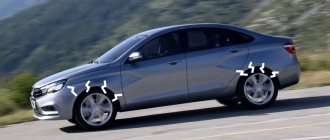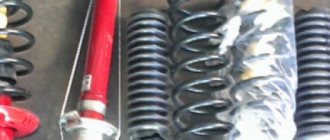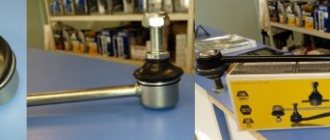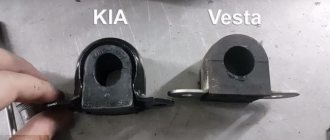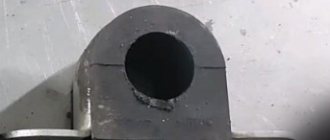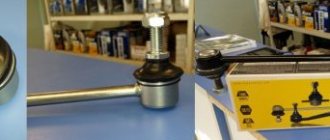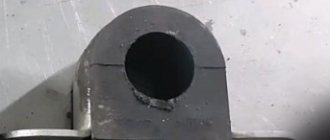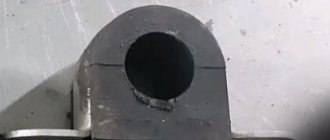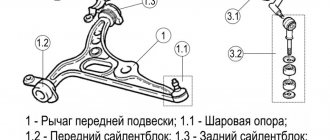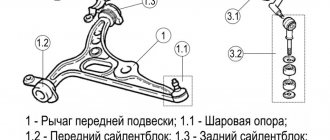The front and rear suspension of Vesta differs significantly from the one that AVTOVAZ used on Grant, Priora, Kalina, etc. All the reviews tell us that the new chassis design is better than before. However, during the first months of operation, the owners began to notice extraneous noises (knocks, creaks, rattles, crunches) in the front and rear suspensions of Vesta, which occur when driving over speed bumps or other road irregularities...
Rattle in the front suspension on Lada Vesta
The most common cause of squeaking is the stabilizer bushing
The increasing grinding noise of the front suspension of the Lada Vesta is especially worrisome, because the main load , the steering and braking systems are located, the condition of which must always correspond to the norm.
A front-wheel drive car, as in our case, is prone to problems with the nose.
Creaks in the suspension are Vesta's disease!
Even new Vestas begin to creak after a short period of operation.
Inspection of the front suspension.
The very first cause of the malaise is considered to be an unfinished design of polyurethane stabilizer bushings , which almost immediately begin to make groaning sounds when driving through plump speed bumps. In wet weather he begins to moan constantly, which is very exhausting.
This problem can be corrected in several ways, radical and not so radical:
- Replacement of pillows with analogues from Chevrolet Niva or other suitable foreign cars.
- Regular application of mastic to places where polyurethane rubs against metal.
- Wait until AvtoVAZ corrects the defect, inviting everyone to the service station for a replacement.
Our Lada Vesta in the “Comfort” configuration (570 thousand rubles), after driving from Moscow to Irkutsk, switched to the mode of everyday city use and is approaching TO-2 and 30,000 km.
The excitement around Vesta has subsided, the time has come for “group therapy”: at the plant they are changing the management that gave Vesta to the world (yes, it sounds loud, but so be it), and they are sorting out the import substitution of components for a domestic new product. Car dealerships have launched sales in “non-rated” cities, the first buyers have already undergone the first maintenance, and mechanics have seen the unknown animal in person. The media reported an impending price increase. So now I have not a modest couple of hours for a “snack” with Vesta, but a couple of weeks in order to understand the entire taste palette of the domestic automotive headliner.
But Vesta has taste. And the smell, alas, too. There is a common belief that the “smell of a new car” is alluring and intoxicating. I suppose, if we are talking about luxury cars, it definitely attracts. If you talk about the budget segment, it’s intoxicating. Out of habit, even my head hurts. But a thorough wash and a new fragrance solve the problem.
However, you can’t drown out the suspension cacophony with cleaning and shampoos; you have to go to a service center. However, more on this later, but for now it would be nice to refresh your memory of the pros and cons of Vesta the blonde, which have already been forgotten since meeting Vesta the brunette.
The first impression was good: the interior is nice and modern, albeit made of hard plastic (by the way, Vesta approached the 28 thousand km mark without “crickets” - this is a record and a sensation!). But in everyday use I begin to notice ergonomic incidents. The seats, which at first seemed comfortable, still disappoint with their imperfect profile when driving regularly: the head is fixed by the headrest, but the shoulder blades “hang”, and there is also a dip in the lumbar region. Yes, there is lumbar support, but it works according to the “on/off” scheme, that is, the lower back is either in zero gravity, or between it and the back of the chair is like a hard rolling pin. Therefore, on average, I adjusted the landing once a day; fortunately, in addition to four seat adjustments, you can move the steering wheel in two planes. The heating of the seats, by the way, is also ambiguous, “two-point” - it warms (fries!) exactly in the middle of the cushion and backrest. Although it may just be a matter of landing geometry.
The control unit for the power windows and mirrors is inconvenient - you have to reach for it, the armrest of the driver's door is poorly positioned, the cup holders in the central tunnel can only hold coins or, for example, a round flavor, everything else falls out of them.
The driver's door armrest suggests holding your hand either too low, at knee level, or lifting it high up, almost to shoulder level
But when your hand is on the steering wheel, there is nowhere to put your elbow
The moves of the manual transmission lever are clear, but long, there is no “fool proof” when engaging reverse gear, the tracks on the radio switch with an unpleasant buzzer, the overly compact pedal assembly every now and then clings to the edge of the shoe, and the clutch pedal pushes the driver’s foot too hard in traffic jams.
Here, in fact, is the entire list of the main ergonomic “jambs” of Vesta, which, really, you can get used to. Not much, you'll agree. But there is one drawback that I’m afraid you won’t be able to get used to: visibility. Yes, Vesta has good mirrors (I would like those on the Duster instead of the standard “cosmetic bags”!), but the A-pillars are just a waste. If you approach a railway crossing, then in the approaching Moscow-Vladivostok train, only the locomotive and the last carriage will be visible from behind the front pillars of Vesta. Joke. But with some truth - the Land Cruiser 200 and Infiniti QX80 are hiding behind the “frame” playfully.
Do you see the Kruzak and Infiniti? And I don't see...
And they are
And if you consider that in addition to other road users, the enemies also included imperfect roads with an abundance of traps, then I was constantly forced to bend over to assess the entire road situation. So we had to ride, rocking back and forth. From the outside, he probably looked like Leonid Viktorovich Slutsky during a nervous football match.
Vesta has no problems with parking - even in such tight windows she crawls effortlessly
Apparently, this is where the notorious difference of 50-80 thousand rubles compared to competitors in a similar configuration is located - in the little things and rough edges.
Yeah... The chrome coating could have stayed on the nameplates longer
Plus a discount for the fact that the product is domestic (well, almost). Plus a discount on the fact that beyond the Urals, flowerpot haters and Ladophobes are still the majority. Plus a discount on the fact that a car of a Russian brand should not cost more or the same as a foreign car of a similar class - somehow it happened historically. Aren't there too many "pluses"? Time will tell - so far Vesta is at the forefront of sales.
After all, if you don’t love, then there is objectively a reason to sympathize with Vesta. It has a really well-honed trident of engine, transmission and suspension. Personally, I like it on the go more than the Siamese Korean twins Solaris and Rio, and even more so the budget-friendly Logan - it’s more exciting and, if you drive fast and “with all your money,” it’s safer. We are talking about active safety, as you might guess (God forbid everyone talks about passive safety only in theory). Well, Vesta, as befits an aborigine, is enviably calm about the shortcomings of our test sites, which are called roads in the old fashioned way. Although it is far from acoustic nobility. And is it achievable - in such and such a price segment?
The front windows are already scratched by hard seals
A spacious trunk can also be added to the asset (four 16-inch “slippers” are placed in the luggage belly with a reserve, a children’s tricycle, two large child seats stand up in “combat” form - all this is not at the same time, of course), and not bad for the usual VAZ engine dynamics with low fuel consumption. Space on the back seat has never been an important criterion for me, but people praise it, so we also tick it.
Take it or run? On the one hand, Vesta suited me almost completely as a traveling city car. On the other hand, lately I have begun to consider myself one of those who are ready, for the occasional opportunity to fill the trunk with belongings and leave the city (including light and medium off-road) for the rest of the time to carry the “station wagon air” around the city. This is a hint at the LADA Vesta Cross, which, judging by the pre-production samples, is good-looking, and - let's be optimistic - will also appear with all-wheel drive. But for now this is all from the category of reasoning and hypotheses. And not so much because there is no universal on the assembly line yet - in addition to emotions, there is common sense and all-Russian experience. Let's call it in Hollywood: The dark side of the Vesta.
The first kilometers behind the wheel of Vesta evoked an irresistible desire to call for a service center - the rumble of the rear suspension and the creaking of the front hit my ears mercilessly.
It would seem that a dealership car with warranty mileage is a direct route to a branded service! But no, we Russians, especially on the Lada, must first go to “Uncle Vasya”, because his emotional verdict is much more interesting and useful than the dry orders of the officials. I have a mechanic friend whom I was hoping to surprise with a visit to the new product. However, the phrase on the phone “what a day it is today, first Shniva, now Vesta” destroyed the illusion. And his look at Vesta lifted up on the lift - the look of an experienced gynecologist at a familiar object, without an ounce of emotion - strengthened my suspicions: there will be no swearing, scratching the back of the head and cursing the crooked hands of the assemblers. But first things first.
Vesta has no specific design flaws; everything is done with an eye on proven European and Japanese designs. But, of course, it cannot be done without nuances.
Either steel clamps or plastic ones. There is no uniformity in the details under the hood of Vesta yet
There are not many complaints about the suspension. The front silent blocks of the levers are inconveniently located at the front - to get full access to them, you need to remove the subframe, the brake calipers rattle (apparently, the “fingers” are too small in diameter). Fastening the front strut cups (with bolts) is inconvenient both from the point of view of installation and from the point of view of the durability of the bolt threads. The “stud + nut” scheme, as, for example, on the Priora, is more practical and reliable.
Not the most successful support mounting scheme: during installation, the stand needs to be held and attached to the screws. The scheme with a stud and a nut on top is much more convenient
The rear suspension is very similar to the VAG one used in the mass-produced VW Polo and Skoda Rapid models. The main advantage is the design of the shock absorber support, thanks to which it can be changed without removing the wheel. But such a support also has its own nuance - it is not dismountable (you cannot separately change the rubber part of it, which is subject to wear, only the entire assembly).
The thermal protection of the muffler is securely fastened with self-tapping screws, but the thermal casing of the gas tank is on flimsy clips, which, with systematic vibrations, are very likely to leave their regular places, and the protection will begin to jingle.
The thermal casing of the gas tank is secured with such miniature and delicate pistons - they will never fly off on our road vibration stands
The rubber brackets of the exhaust tract are also weak - the front one has already torn at 26 thousand miles, the rear one is still holding up.
The front exhaust tract mount has already given in, the rear one is still holding on
And also a little sad news for fans of cutting springs, installing multi-inch wheels and other embellishments that are paradoxical for our roads - apparently, Vesta’s designers were faced with the task of doing everything possible to protect the model from this kind of tuning. The distance between the rear shock absorber and the wheel is minimal, the gas tank pipe is also in close proximity to the tire. That is, wheels larger than the 16-diameter provided by the factory cannot be installed here, at least without surgical intervention in the structure.
The distance between the shock absorber and the wheel reduces the likelihood of wide rubber appearing in the arch
Under the hood, everything is familiar and without innovation. Among the nuances are flimsy fastenings of the plastic engine cover, not the most reliable clamps of the air filter box (in the cold they can burst if you change the filter “to a cold one”), and a mixture of clamps and chips.
It’s unlikely that anyone will bother to change the air filter in the cold, but it’s worth considering that flimsy latches may not withstand such an experiment
“Uncle Vasya’s” verdict: if the quality of the components (mostly bushings, seals and suspension silent blocks) is at an acceptable level, then Vesta should not cause significant problems for a long time. True, some components (for example, stabilizer struts) are already included in the list of childhood diseases.
Well, the consumer characteristics are normal, the machine is not bad structurally. Let's move on to the most interesting part - the human factor.
In Irkutsk, sales of Vesta started in January; in three months, only about 30-35 cars were purchased (I did not request official data, information from the words of the personal manager of Lada Vesta in Irkutsk). Therefore, when I called the AvtoVAZ dealer to make an appointment to diagnose and eliminate suspension noise, the girl operator listened to me as the owner of the spacecraft and answered confused and a little scared. In general, I have the impression that everyone at AvtoVAZ is afraid of Vesta, except for the marketers: the management was fired because of it, dealers are afraid that the car “won’t work” because of the high price, in official services they look with alarm at everyone who comes into the pit Vesta - suddenly pry bar and welding are no longer universal means of repair? And in general, because of this Vesta, there is one headache: you need to go to training, meet new quality and image standards, respond to citizens’ complaints, analyze and correct breakdowns and design flaws. Quiet horror, in a word. It’s good that smoking hasn’t been banned in the pits yet...
... They booked me for a weekday evening (the warranty manager doesn’t work on weekends, so you need to come only on weekdays, and only before 18:00 - the warranty manager only works that way, they explained this to me over the phone). Further, the story will be told in the first person, and since Drom.ru stands for purity and culture of speech, I will replace all profanity with the word “AvtoVAZ”.
While I was waiting for the inspection technician, I looked at the diagnostic card, on which for some reason an old Opel Omega was schematically depicted instead of Vesta. Minor marketing miscalculation!
“Good afternoon, my name is Ivan, I am your personal manager,” a young man in a Lada branded robe distracted me from my thoughts.
“This is exactly how, in Russian, Ivan should be called every personal manager of the Russian Vesta, it will be both symbolic and brilliant at the same time,” I thought.
“Seryoga, pour me this car drink, I’ll take it to the garage,” an elderly worker with several plastic canisters at the ready interrupted my thoughts again, walking past Vesta and not even looking at her.
Ivan, while they were figuring out which lift to put Vesta on, immediately pointed out another “sore” of Vesta: a dent on the hood in the area of the lock. I thought that the stones were to blame, but no - these dents are in most cases man-made, when the hood is not slammed, but pressed.
According to my calculations, 9 service workers came one by one to see the raised Vesta. True, only one looked at the bottom with outright surprise and interest; the rest, holding their gaze for about five seconds on the front subframe, took a deep drag on a cigarette and left to finish their routine - some of the Priora, some of the Chevy Niva.
First we decided to deal with the squeaks of the front suspension. Today, Google, unfortunately, knows more about the causes of certain Vesta malfunctions than the officials, so the guys don’t know about the stabilizer bushings yet, and at first the mechanics didn’t have a ready-made solution.
— I guess we need to change the front silent rings... — Don’t worry about driving! Here, to change them, you need to unfasten the subframe and the rack, we’ll do it in a car! - What should we do then? - Well... Take the van and spray it on the stub bushings. It should get better.
Since I was “on duty”, I did not interfere in the creative process for the purity of the experiment (may the service workers forgive me - everyone has their own job). So let them fiddle with it; they will always have time to remove the subframe.
With knocks from the rear suspension it turned out to be even more difficult, since, in theory, there is little that can knock there except the shock absorbers themselves. We seemed to have heard about the design flaw of the shock absorber supports, but we decided to start by limiting ourselves to tightening the parking brake cables with clamps (to be fair, they did rattle and required additional fastening).
After all the manipulations, we went for a second test run. There are fewer creaks in the front suspension, but the rumble from the rear has not disappeared at all. Upon our return, we were met by one of the mechanics, already dressed in civilian clothes (of course, it was 18:02 on the clock!).
- Well, is it knocking? - Knocks - What a bitch! Alright, goodbye. - Goodbye…
Here we were again joined by a warranty engineer who was temporarily busy with other cars, who was aware of the source of the problem and ordered to remove the rear shock absorbers and look at the condition of the supports. In the meantime, he himself went to the warehouse to find out whether the modernized parts had arrived from the factory (since January, the factory had already begun installing other supports - there is reflection, and work on mistakes is underway!).
At first it seemed that the gas tank and the gas tank tube were a single whole; the AvtoVAZ mechanics even tensed up a little when I asked if this was so. “Dismountable,” the servicemen reassured me after consulting. And they themselves calmed down
The required part was not available, so we used the traditional method - spacers made of washers 2 mm thick. The gap between the body and the supports, formed due to the spacers, was filled with sealant at my prompting.
If there's nothing on your car you can fix with a plastic zip tie, duct tape, or WD-40, it's not a car. Vesta - car
Then the guys hastily collected all the belongings from the trunk, which they had taken out to diagnose the rear suspension (read rocking of the body without extra luggage), along the way discovering an extra clip, the “homeland” of which they could not find. They agreed that the clip had been planted. Perhaps even ill-wishers. When they rode for the third time and were convinced that the noise had gone away, the workers breathed a sigh of relief. And satisfaction! After all, the first small victory in a long game called Vesta.
But not everything is as sad as it might seem. The ice at AvtoVAZ has really broken and the vector of development, albeit slowly, with a creak (we need to put a car in AvtoVAZ!) is turning in the right direction. At the service reception, they politely apologized for the fact that the diagnostic sheet was printed on crumpled paper due to a printer malfunction; after my visit, the personal manager called several times and clarified when I would be able to arrive to finally eliminate the squeaking of the front suspension (they didn’t do it enough). Damn nice! And unusual. I would like to believe that this is not because of the Droma stickers on board, and this kind of customer focus applies to all Vesta owners.
True, the process of “rehabilitation”, I sense, will not be quick. But that’s not why I wouldn’t buy Vesta now. Let it (like any other automotive novelty, not only domestic, it should be noted) suffer from all childhood diseases, lose most of the components of questionable quality, acquire “life hacks” and a good accessory base (and it is growing on Ladas by leaps and bounds ) - then buying Vesta will not be an experiment with a slight touch of patriotism, but the choice of a practical person and not devoid of automotive taste.
Egor Klimov, entrepreneur, drives a Renault Duster
Special opinion of Drom.ru journalist Vasily Larin
- If the prices are ridiculous, then the quality will make you laugh...
Looking at the new AvtoVAZ product, even just taking a quick glance at it, the first thing I want to note is some kind of Gagarin-like flight beyond the boundaries of the quality usual for the brand. There seems to be nothing even close to anything in common with the sunken “Samaras” or “tens”. But the same “99th” was once a measure of incredible cool - for a model in a fashionable color on the “black” market, all kinds of “cooperators” asked for a price that was not at all proletarian. And the design of the “brass knuckles” was symbolic during that combat period. Intelligent Vesta appeared in a different era - the image is not “gangster”, foreign popular brands are named among its competitors, but the official prices are not at all ridiculous. It’s a difficult, treacherous time, everything is much more confusing than in the troubled 90s.
To understand whether Vesta is worth the money, you need to answer whether it is worth its classmates. Those who were born in the desire of leading brands to occupy the lower echelons, while for AvtoVAZ this is a rise. Has it reached, jumped over, is it worth them in detail and in general. Looks like a Volkswagen? Yes, there is something German-like in the suspension that is rigid, dense, and stable. There are clear efforts and reactions in control, and the steering wheel itself is incredibly good, as is the manual gearbox lever, and in terms of engine responsiveness, especially from 2500 rpm, the Vesta is superior to both the Polo and the naturally aspirated Rapid. Similar to Hyundai, Kia and Ford? The appearance of Solaris, Rio and Fiesta is individually different, the interiors are not dull, and the ergonomics are well-developed. The new Lada is at least not inferior to them in this, and in some ways it is superior - it looks decent, the inside is nice, spacious, and comfortable. The ergonomics are on par, the working elements are mastered intuitively, although you can stumble upon details that clearly haven’t been worked on - for example, the side chair adjustment lever.
Wait, we’re talking about a VAZ car, but it’s just some lever that’s annoying? Not only that, but the A-pillars are made wide like a Van - they give a feeling of protection, but they block frontal and side visibility. Well, the gas pedal could have been more informative, and the gearbox drive could have been clearer during quick shifts. This is where the phantom pursuit of the “merits” of the brand begins, and you involuntarily expect a catch.
I also remember an alarming trip on Dromov’s Lada Granta Sport, when on the road in the far northern regions an engine mount burst, and it made you laugh out loud. It seemed like he had already put an end to Lada’s word, but no - suddenly an “innocent blonde” who had appeared from somewhere seduced him into a three-day rendezvous, by the way, with a trip to gravel and forest paths out of sight.
In general, the impressions are positive; indeed, it is not for nothing that the car is compared with inexpensive foreign models. Apart from a number of "rough" settings, under normal conditions there is no fundamental difference.
The limitation in power only affects highway modes. But off the asphalt, thanks to the ground clearance and energy-intensive suspension, Vesta is the same “tank” as its ancestors. Even despite the developed front overhang, you can not really maneuver among the gullies of unkempt gravel and turn around on a country dirt road with ruts. And the fuel needle doesn’t seem to be in a hurry to dry up, and 92nd gasoline is registered as native along with 95th. It is not surprising to be interested in such a practical question - what will long-term ownership entail? Based on official sources, scheduled maintenance at a dealer, say, up to a mileage of 90,000 km, will cost, although cheaper than that of foreign classmates, but not much, given the choice of more expensive consumables.
And yet, it seems that it would not be entirely fair to rhyme Vesta and Fiesta in one egalitarian verse. Extraneous and not at all muffled noises emanating from the suspension and gearbox evoke “nostalgia”. Again, the mileage is only 28,000 km, and the “chrome” is already peeling off from the proud Lada inscription on the trunk lid. What else can we expect? In addition, I would like to improve the level of service - the prices are not at all ridiculous, so a mature client has the right to count on this.
Photo by Sergei Volkov
Photo bonus: Belaya Vesta and spring on Baikal
Problem with stabilizer links
The problem with squeaks in the front suspension can be solved by replacing the stabilizer bushings with polyurethane.
If after performing one of the operations the grinding does not stop, then you can go further down the list.
What else could be wrong with stabilizers? The design has a strut that is attached to the shock absorber body and the cross member of the stabilizer itself. It has two fingers as fastening. Without diagnostics at a service station, it will not be easy to figure out whether there is a breakdown in this unit, but you can try.
Official opinion of AvtoVAZ
Dealers replace stabilizer links free of charge. But sometimes you have to butt heads!
The problem with the struts is not far-fetched , since in April 2021, official representatives of AvtoVAZ reported that they knew that after just a few thousand kilometers Vesta was already detecting knocking and creaking noises from this particular unit. This important element experiences special stress and wears out prematurely.
There was no word on whether the fault was a manufacturing defect.
Replacement of struts on Lada Vesta for free
Replacement of squeaking elements at the dealer should be free of charge. All questions can be resolved by calling the hotline!
However, all car owners who complain about the performance of the struts during the warranty period will have them completely replaced at the dealership free of charge .
It is noteworthy that we are not talking about installing a repair kit, but a complete replacement of the unit.
So, if the warranty has expired, you will have to try to solve the problem yourself. The replacement process is simple. After inspecting the removed parts, you can decide whether to replace the entire mechanism or limit yourself to a repair kit.
We eliminate squeaks, knocks and crunches in the front suspension of Lada Vesta
A squeak that resembles rubber friction or a dull sound tells us that the muffler mounting is insufficiently lubricated or that the stabilizer bushings (8) are of poor quality. In the case of a muffler, it is enough to lubricate the fastenings with grease. The rubber bushings of the stabilizer will have to be replaced, since lubricant, even the best one, will not help for long.
Knocking in the front suspension most often occurs due to wear on the stabilizer struts. As in the case in the video below, there is only one solution - to replace worn out struts to eliminate extraneous noise.
Other causes of squeaks in the front suspension
Lada Vesta does not have any other serious problems other than those listed above.
The front suspension is designed reliably, similar to foreign brands, taking into account long-term use.
Quite often, extraneous squeaks are caused by brake calipers.
There are isolated cases where the following types of breakdowns have occurred over time:
- The silent blocks of the steering gear levers require , which are extremely inconvenient to remove.
- Brake calipers may gradually begin to click , replacing the pins may solve this problem.
- A small play appears in the place where the strut cups are attached to the body , associated with wear on the threads of the mounting bolts.
conclusions
In addition to these factors, time plays a decisive role.
If the service life of some units has come to an end, then they need to be replaced urgently, since one breakdown can lead to others, and the entire mechanism will go into disarray.
If we return a little to squeaks, then with significant fatigue of the ball joints, steering tip and rack, failure of the shock absorber, or its broken supports, unnatural irritating sounds may appear. Then it is best to go for a diagnosis and then treat the problem.
